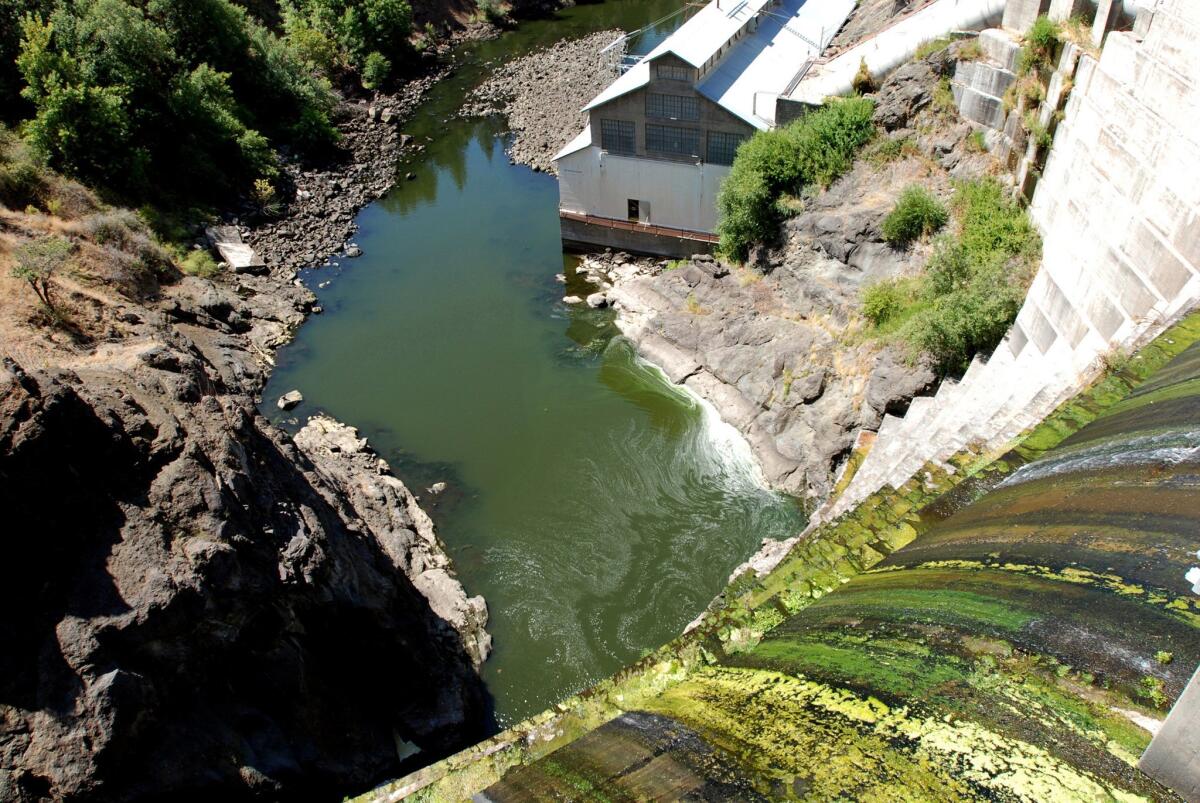Op-Ed: Warren Buffett can save the Klamath River Basin. Will he?

- Share via
It should not take pleas to Warren Buffett, the billionaire leader of the Berkshire Hathaway holding company, to save the wobbling deal to take down four obsolete dams on the Klamath River.
But that is what the state of California and the Klamath’s Yurok and Karuk tribes are left with after a two-decade-long campaign to restore the ecosystem — and especially the salmon runs — of the Klamath River Basin. The dam removal, potentially the world’s largest such project ever, is crucial to the survival of the tribes, the fishery and the river itself.
Berkshire Hathaway’s subsidiary, PacifiCorp, a Pacific Northwest utility, owns the four Klamath dams, which would make Buffett, as chief executive and chairman of Berkshire Hathaway, accountable for a cultural and environmental catastrophe that the utility is poised to make worse.
The dams range from 55 years old to more than a century old, and they generate relatively little electricity. Their reservoirs these days are cauldrons of highly toxic blue-green algae, and they block the path of salmon that have made their way down and up the Klamath, one round trip per lifetime, for thousands of years. All of the river’s salmonid species are now either extinct or in severe decline.
If the dams are allowed to stand, it would deliver a punishing blow to the Yurok and Karuk, who have struggled to maintain their salmon-centric cultures, and it would ensure that the river’s appalling water quality would further deteriorate.
Considering the harm caused by the dams, PacifiCorp got a great deal when it agreed to their removal in 2010. The demolition project’s cost was pegged at $450 million. California voters approved a 2014 water bond measure that contributed $250 million, and PacifiCorp was allowed to raise another $200 million by assessing its customers a surcharge. The removal was delayed for a decade to enable the company to collect its share of the money, even as the river and the salmon population continued to decline.
As a “bedrock principle,” PacifiCorp has insisted that it would not accept liability for any costs beyond the dams’ removal, such as overruns or mitigation of problems that removal itself could cause. To deal with this demand, the tribes, environmental and fishing groups, and government agencies created a private nonprofit company, the Klamath River Renewal Corp., whose sole purpose is to take ownership of the dams and oversee their dismantling. It, not PacifiCorp, would be responsible for any additional liabilities. With California’s contribution, the surcharge and the creation of the new corporation in place, the four dams’ removal would end up costing PacifiCorp’s shareholders nothing.
But in July, the Federal Energy Regulatory Commission, which licenses dam removal, partly undid the deal. FERC approved the demolition, but only on the condition that PacifiCorp remained a co-owner through the process. According to some of the negotiators, that isn’t an unreasonable imposition: FERC, which is far from a hotbed of anti-dam advocacy, sees value in PacifiCorp’s experience with previous dam removals, and with other dam removals under consideration throughout the nation, it may not have wanted to set a precedent that allows dam owners to escape all liability for their dams.
An illustrated guide to Democratic National Convention highlights. On Night 4, Joe Biden touts hope, facts and fairness as an antidote to GOP chaos.
In a brief statement, PacifiCorp indicated that it wanted to continue to negotiate a solution, but a week later, it also invoked a termination clause in the removal deal. The threat to end the project is puzzling because the long-term alternative to removing the dams — relicensing them for continuing operation — would cost the company more than its ratepayers’ share of the dam removal price tag, and far more than the potential liabilities they want to avoid. Relicensing would require the company to install fish ladders on the dams, at a cost expected to range between $450 million and $800 million. Considering that the dam removal deal contains insurance and bond provisions to cover costs in addition to demolition, removal advocates say PacifiCorp’s later liabilities wouldn’t amount to more than a few million dollars, if that.
Of course, as long as the dams remain in limbo, neither consigned to demolition nor relicensed, PacifiCorp can profit from their hydroelectricity generation without having to install ladders. Those revenues — which were estimated at $24 million in a 2012 federal environmental impact statement — may explain why PacifiCorp is dithering.
Still, PacifiCorp — and Buffett — are faced with an existential choice. As Gov. Gavin Newsom said in a July 29 letter addressed to Buffett and PacifiCorp’s leaders, the company should make good on what is “an unprecedented moment of reckoning about our past and, more importantly, our future.” Failing to take down the dams will guarantee the Klamath River Basin’s continued decline, and in a time of growing awareness of the Native American genocide and its legacy, it would tell the tribes the same old story: They don’t matter.
Jacques Leslie is a contributing writer to Opinion.
More to Read
A cure for the common opinion
Get thought-provoking perspectives with our weekly newsletter.
You may occasionally receive promotional content from the Los Angeles Times.











